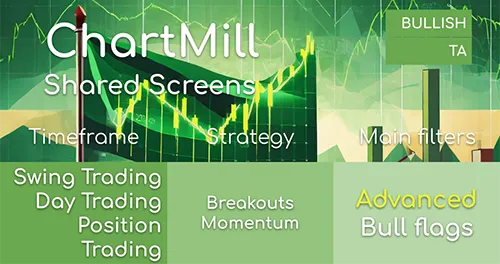High Tight Flag Pattern; How to Profit from this Explosive Breakout Setup?
By Kristoff De Turck - reviewed by Aldwin Keppens
Last update: Jan 22, 2025
The "High Tight Flag Pattern" stands out as a rare yet highly bullish signal that can indicate a significant upward price movement. In this article, we'll delve into its key features, and why it holds such promise for savvy traders.
What is a High Tight Flag Pattern?
A high tight flag pattern is a chart pattern that signifies a potential for substantial price appreciation. I like to refer to it as a "Bull Flag on steroids". The concept is not new and I first saw the term in Mark Minervini's book, "Think and Trade Like a Champion". He describes this pattern as "The Power Play".
“...the power play, also referred to as the high tight flag. This is one of the most important and profitable setups to learn—and one of the most misinterpreted among all the technical patterns. If you get it right, though, it can be one of the most profitable.” - Mark Minervini
Swedish swing trader Kristjan Kullamägi also uses the High Tight Flag as the basic pattern for his breakout setups.
The pattern is characterized by two distinct phases: a strong prior uptrend followed by a tight consolidation phase.
Strong Prior Uptrend
The first phase of the high tight flag pattern involves a sharp, nearly vertical rise in the stock price. Typically, the stock will gain at least 25% to 100% or more within a short period, usually between 4 to 8 weeks (or even less). This dramatic increase sets the stage for the pattern's formation.
Consolidation Phase
After the rapid ascent, the stock enters a consolidation phase where the price moves sideways within a narrow range. This phase often forms a small rectangular shape on the chart and lasts between 1 to 3 weeks. During this time, the stock should not retrace more than 10-20% from its peak. This tight consolidation indicates that investors are holding onto their shares, anticipating further gains.
Low Volatility
A hallmark of the consolidation phase is decreased trading volume. The reduced volume suggests a lack of significant selling pressure despite the previous sharp increase, indicating strong investor confidence in the stock's future performance. Investors are holding onto their shares in anticipation of further gains.
Breakout
The high tight flag pattern is confirmed when the stock breaks out above the upper boundary of the consolidation range on increased volume. This breakout signals a potential continuation of the prior strong uptrend, making it a highly bullish indicator.
Example of a High Tight Flag

On Nov. 1, Microstrategy Inc (MSTR) published quarterly results (after market close). Leading up to these quarterly results, the stock was already up more than 40% and a high tight flag pattern was formed. The difference between the top and bottom of the pattern was only 11% and volume was low. A clear consolidation phase with declining volatility.
The following day the price opened with a gap up but intraday the upper side of the high tight flag pattern was tested. As a swing trader you had the chance to buy the stock at this point with a stop loss below the flag pattern. In the meantime, the price is again up more than 50%....
Why is the High Tight Flag Pattern Important?
The high tight flag pattern is considered a powerful bullish signal due to several reasons:
Momentum - The sharp initial rise indicates strong momentum, which can propel the stock price higher.
Investor Confidence - Low volatility during the consolidation phase suggests that investors are confident in the stock's potential, reducing the likelihood of a significant pullback.
Potential for Significant Gains - When the breakout occurs, it often leads to substantial price appreciation, providing traders with lucrative opportunities.
Why the High Tight Flag Works: The Psychology of Explosive Breakouts
The High Tight Flag pattern reflects extreme bullish momentum and strong institutional demand. The initial rapid price surge (often 100%+ in a short period) signals aggressive buying, usually driven by positive earnings reports, strong industry trends, or major news catalysts.
When the stock consolidates in a tight range instead of pulling back sharply, it shows that sellers are scarce and buyers are still in control. This period of low volatility allows the stock to absorb profit-taking while maintaining its uptrend.
When finally a breakout occurs, it often triggers a fear of missing out (FOMO) among traders, further fueling the next leg higher. This combination of strong demand, limited supply, and breakout momentum makes the High Tight Flag one of the most powerful continuation patterns in technical analysis.
How To Trade This Pattern?
Example trade plan based on the daily chart of Novocure Ltd [NASDAQ:NVCR]

Entry Point
Place a buy order slightly above the breakout point to confirm the breakout. This ensures you enter the trade as the stock moves out of the consolidation phase. Always use Buy Stop Limit orders.
- Buy stop - $23.00, Limit: $23.15
Stop Loss
Set a stop-loss below the lower boundary of the consolidation range or a recent support level. This helps protect against false breakouts. Always use a Stop Loss Market order.
- Stop Loss: $21.00
Position Size
Determine the size of your position based on your risk tolerance and the distance between your entry point and stop-loss level. This ensures you don't overexpose your portfolio to a single trade.
For example, if willing to risk 1% of your portfolio on this trade and your portfolio is $10,000, then:
Risk per share = Entry Price - Stop-Loss Price = $23.00 - $21.00 = $2.00
-
Maximum risk per trade = 1% of $10,000 = $100
-
Position size = $100 / $2.00 = 50 shares
Set Profit Targets
Define profit targets using technical analysis, such as previous resistance levels or a multiple of your risk (e.g., 2:1 or 3:1 reward-to-risk ratio).
In this example if you are aiming for a 3:1 profit target, the target price will be
-
Risk per share = $2.00
-
3:1 ratio = $2.00*3 = $6.00
-
Profit target = $23.00 + $6.00 = $29.00
Using a 3:1 profit target will ensure you that even with a batting average of only 30%, you still will be profitable!
- 70% losers: $2.00 * 7 = 14
- 30% winners: $6.00 * 3 = 18
- Profit = $4.00
By following these steps, you can effectively trade the high tight flag pattern shown in the chart. Always remember to use proper risk management techniques and adjust your strategy based on the market conditions.
FAQ
1. How rare is the high tight flag pattern?
The high tight flag pattern is relatively rare due to its strict criteria. However, when it does occur, it often signals a strong bullish trend.
2. Can the high tight flag pattern occur in any stock market?
Yes, the high tight flag pattern can occur in any stock market, including large-cap, mid-cap, and small-cap stocks, as well as in different sectors.
3. What if the breakout fails and the stock price declines?
If the breakout fails, it's essential to have a stop-loss in place to minimize losses. Set your stop-loss below the lower boundary of the consolidation range or a recent support level to protect your capital.
4. How can I increase the accuracy of identifying high tight flag patterns?
Using reliable stock screening tools like Chartmill can help you accurately identify high tight flag patterns. Additionally, combining this pattern with other technical indicators and market analysis can increase your accuracy.
5. Should I consider the overall market trend when trading high tight flag patterns?
Yes, considering the overall market trend is crucial. Even strong patterns can fail in a bearish market. Align your trades with the broader market trend to improve your success rate.
You are probably interested in this as well
Bull Flag Chart Pattern Explained
This is a continuation pattern within the field of technical analysis. Read more...
Bull Flag Trading, How To Do It?
This 'Bull Flag Trading'-guide explains how to take advantage of the pattern, both as a swing and daytrader. [Read more...](This 'Bull Flag Trading'-guide explains how to take advantage of the pattern, both as a swing and daytrader.)







